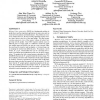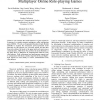61 search results - page 5 / 13 » The diameter of random massive graphs |
SIGMOD
2010
ACM
14 years 1 months ago
2010
ACM
Maximal clique enumeration (MCE) is a fundamental problem in graph theory and has important applications in many areas such as social network analysis and bioinformatics. The prob...
WAW
2007
Springer
14 years 2 months ago
2007
Springer
A random graph model based on Kronecker products of probability matrices has been recently proposed as a generative model for large-scale real-world networks such as the web. This...
ASUNAM
2010
IEEE
13 years 10 months ago
2010
IEEE
Subgraph matching is a key operation on graph data. Social network (SN) providers may want to find all subgraphs within their social network that "match" certain query gr...
CSE
2009
IEEE
14 years 3 months ago
2009
IEEE
— We examine the social behaviors of game experts in Everquest II, a popular massive multiplayer online role-playing game (MMO). We rely on Exponential Random Graph Models (ERGM)...
STOC
2004
ACM
14 years 2 months ago
2004
ACM
Several peer-to-peer networks are based upon randomized graph topologies that permit efficient greedy routing, e.g., randomized hypercubes, randomized Chord, skip-graphs and const...


